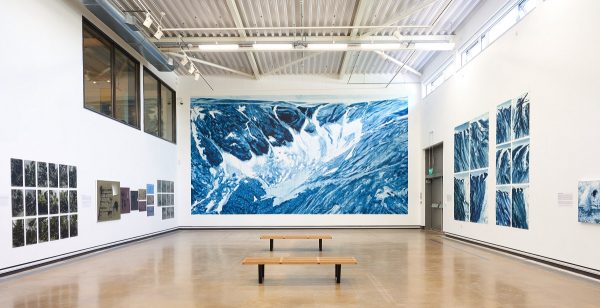As someone who prefers to work with digital art rather than traditional, I can draw inspiration from Mik Godley, an artist who uses an iPad and mobile phone, rather than a traditional art school lecturer based in Nottingham. He is a painter who uses both traditional painting techniques and digital technology. This exhibition is a major presentation of Mik's ongoing body of work, 'Considering Silesia,' which began in 2003 and has been the focus of his work for almost twenty years. Mik’s work has been exhibited from San Francisco and Baltimore to Zagreb, featured in several publications, and received awards and critical acclaim.
"Considering Silesia brings together the largest and most comprehensive selection to date of paintings, drawings and prints by Nottingham-based artist Mik Godley. But rather than an unfocused retrospective, this exhibition concentrates specifically on works made as an oblique response to his own family’s connection to – and wartime displacement from – the formerly German, now mostly Polish region of Silesia, as mediated by the internet over an eighteen-year period. By Godley’s own account in the various lucid wall texts accompanying the works, it’s a project that began with the acquisition of his first computer, almost as a curious side-project, which rapidly expanded in scope, taking over much of the artist’s time and energy."
Born to an English father and German mother fewer than fifteen years after
WW2, Mik grew up in the Yorkshire coalfields. Once he started school, Mik stopped speaking German and became English. It wasn't until he got his first computer in 2003 that Mik started researching the German side of his cultural identity. The simple idea of "let's see where mum came from" prompted Mik to start researching online and documenting the things that he discovered. The once German but now Polish region of Silesia has a complex political and social history, which Mik has explored in his work for almost two decades.
This vast and wide-ranging body of work not only marks Godley's discovery and deepening understanding of his family history but also records significant changes in the increasingly detailed and immersive experiences of distant places and people that digital technology can offer. Despite having never visited his mother's homeland, Mik has documented the landscape, architecture and people of the region through images, video footage and maps found online.
As digital technologies developed to the point that large amounts of data could be easily stored and shared, and touchscreen devices became more sophisticated, Mik began moving away from traditional drawing and painting to making work on iPads and smartphones. Since around 2014, most of Mik's work has been digitally made.
"Although my drawings usually take several days to produce, iPads and smartphones can be incredibly quick - you don't have to wait for stuff to dry - and allow immediate online dissemination. You can post online or send files to be printed and exhibited anywhere in the world. The iPad and several of the apps are really easy to use; though some of the apps can be complex if needed, they can also be used very simply, which suits me. Then there's the portability. The iPad is effectively a portable studio and can do pretty much everything l need. With the Pencil stylus, it now offers professional-level precision - it's no longer finger painting."
- Godley.
I prefer digital art to traditional art because creating digital art saves time. If you make a mistake on a digital drawing or painting, you can simply press the undo button to start over without making a mess trying to erase the mistake. In a digital creation, you can erase without a trace, change colours easily, and position and resize objects in seconds. Godley shows this with his work 'Lofthouse Colliery Nature Park Looking East.' From a distance, the image looks realistic with its shading and other tones on the underside of the cloud, and different colourations for the leaves on 'Near Nowowiejska 7, Wałbrzych, via Google Street View', but upon closer inspection, it is revealed that the image has neat, unkempt links and squiggles to create its textures and dimensions.
I take inspiration from Godley as viewers can see that the piece of art may look somewhat unkempt with uneven details, but from afar, it looks nice and somewhat realistic, and I have tried to make it work in my work, too.
(Above: Lofthouse Colliery Nature Park Looking East)
(Below: Near Nowowiejska 7, Wałbrzych, via Google Street View)






No comments:
Post a Comment